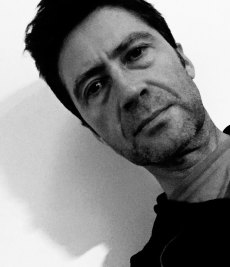
Facing Off Against Desert Chaos. a Toxic Storm and an Extreme Color Grade
George Miller’s post-apocalyptic desert adventure Mad Max: Fury Road captivated audiences and critics with its exhilarating, relentless action and deranged visuals. The brutal extravaganza scored $375 million at the worldwide box office, and 10 Oscar nominations, including best picture, director, cinematography, film editing, costume design, makeup and hairstyling, sound mixing, sound editing, production design and visual effects.
Andrew Jackson was the overall visual effects supervisor working from George Miller’s Sydney, Australia-based production company Kennedy Miller Mitchell (KMM). Tom Wood supervised the visual effects work that started at Method and continued at Iloura (both are divisions of Deluxe Entertainment). Jackson, Wood, and special effects supervisors Dan Oliver and Andy Williams all received Oscar and BAFTA nominations for their work on Mad Max; and Jackson, Wood, Oliver, and producer Holly Radcliffe also received VES nominations. We spoke with Tom Wood about the digital effects in Mad Max.
Studio Daily: What was the best thing about working on Mad Max?
Tom Wood: I have an art training background and have been lucky to work with artistic directors — Ridley Scott, Danny Boyle, and now George Miller. Working on Mad Max was extraordinarily rewarding emotionally and artistically. George gave us a crazy amount of freedom to bring to him what we thought was appropriate from his verbal descriptions.
How many shots did Iloura complete for the film?
We completed 1800, and 1600 are in the movie.
Give us an overview of those shots.
We had maybe 10 full CG shots: three or four huge establishing shots of the citadel — the big rock cliff with crowds below, water pouring out, and the environment beyond; and five or six of the toxic storm. Everything in Mad Max was initially practical, apart from the storm, and we built up to the storm with live action. The all-CG shots tended to be aerial shots, and we tried to keep the camera speed and lens type like what we’d have on an aerial unit helicopter, a second unit-type shot.
We also had lots of simulated travel shots with people driving. We removed green screens [and] projected textures on 3D surfaces. In the big canyon sequence, we added 3D extensions to the rocky cliffs. We put a stump on Charlize Theron’s arm. Added mist. The chase back through the canyon was largely shot with live action, but we added vehicles, sky, and other things that made it feel like we were there traveling across the desert. The vehicles are sometimes CG, but Andrew [Jackson] had shot plates of vehicles. Sometimes we had to project photos and re-render, but mostly they were shot from appropriate angles. When the big fuel truck explodes, it was a multi-camera shoot, so we replaced the camera cars with vehicles you’d expect to see.
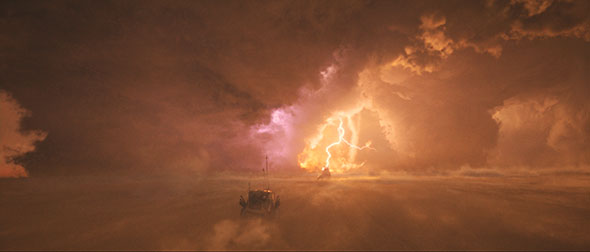
What was the biggest challenge?
The toxic storm was our biggest challenge. We had a live action plate to start us off. Any of the cars driving on the sand and kicking up sand were live action on the sunlit desert in Namibia. We darkened and re-graded the plates and tracked CG cars onto them, but tried to keep as much practical as possible. Then we added 15 layers of CG dust and debris, ankle-deep streams of sand, knee-deep dust lumps, then mini-twisters and piles of rolling dust that engulf the cars and truck. I think there were 79 shots in the storm and five or six were all CG-shots.
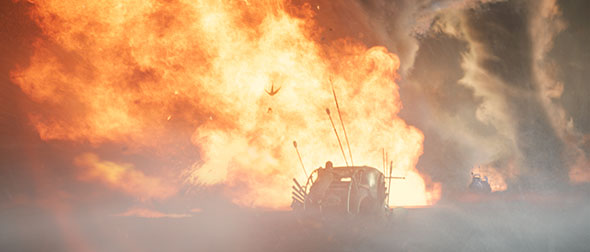
What tools did you use to simulate the dust and twisters?
We used Houdini and a proprietary volumetric tool and rendered through PRMan. The central core of the twister was a proprietary volume tool developed in house. We could take one Houdini particle and make an unlimited number of particles to create an intensely volumetric simulation without having to run all those particles through Houdini.
Click each concept art image to see a higher-resolution version.
On what did you base the storm’s design?
George [Miller] turned that sequence over to us as our first sequence because we made it clear we would need a lot of time. It was relatively undesigned. So I took a series of paintings to him — concept art done in the Method office in London while I was there. He loved them and they were the basis of everything we did. Then it took six to eight months at Iloura to produce shots consistent with George’s expectations.
Did you expect it would take so long?
A huge simulation like that is not something you drive into expecting quick results, and there are economies of scale with it as well. We knew it was something it would be difficult to bid accurately. Ultimately, you try to do the best job on it without much thought to cost because you know there’s so much more of the movie coming.
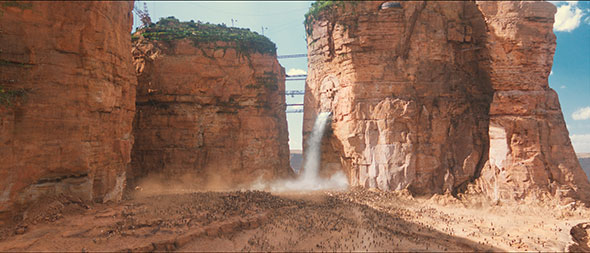
Did you have artwork to draw from for the CG citadel?
George [Miller] had spent a long time designing it over the last 10 years, so there was a lot of artwork. We had a series of meetings with him and then worked under Andrew’s [Jackson] direction. Some of the sequence was previs’d by Andrew’s team at KMM. George hadn’t shot the citadel sequence at all when we started. He shot it at the end of the first year in Sydney at Fox Studios and in a dry reservoir. Andrew did aerial shots of the Blue Mountains west of Sydney, which have 200- to 300-foot-high cliffs. We ran the photos through PhotoScan to get accurate geometry and photoreal textures, which we could cut and paste together to make the citadel. Those establishing shots of the citadel took a long time and a lot of resources to make.
How long did you work on the film?
We had two and a half years of compositing. The intent was to shoot as much as possible and put it back together the way George [Miller] wanted in post. He cut progressively from reel one on through and delivered the scenes chronologically. So we didn’t see anything more than the first reel and the beginning of the second reel for the first year. We’d work on one scene, and then as we finished that one, another would come in.
Was working on the film chronologically helpful?
We were able to have a small team of 60 to 70 that topped out at 110. We kept the same team employed constantly through the film, so we had continuity of crew. The only slight downside was staying focused. When a new scene came in, it was almost like working on a new film.
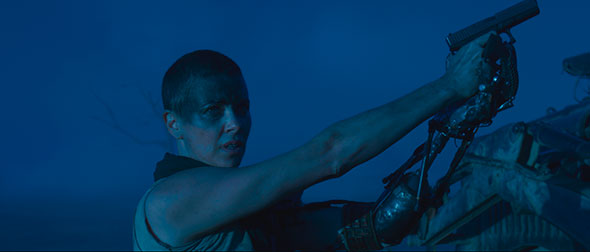
Did the extreme grade on the film affect you?
Definitely. The final grade wasn’t established until the last six to eight weeks. There was a guide grade that we took into account and we were aware of where George [Miller] wanted it to go. We had working LUTs and CDLs from the DI suite per shot and an overall one per scene. So we could watch everything through George Miller-colored glasses and then switch to the shot color supplied to us to see the work underneath. We could see what was breaking in our shot. He wanted a far more extreme look until the end, when he rolled it back, for which we were grateful. Even live-action explosions look kind of unreal with really intense yellows and reds.
Why do you think your colleagues voted for Mad Max: Fury Road to receive an Oscar nomination?
I don’t know. When you’re judging visual effects, it’s hard to judge and stay impartial to how good the film is. We already had a good film, the effects are consistent throughout, and they demonstrate all the things we can do with visual effects. There are no CG characters, but apart from that it had a reasonably wide range of visual effects, the kinds of things you expect visual effects are wanted for in a film. It’s humbling to be in a list alongside the other guys, the other movies. There is an appetite at the moment against CGI, which I think is unjustified and seems to be a bit of McCarthyism — Luddites chasing down VFX and CGI saying it destroys movies. There’s a little bit of a push against big visual effects movies, but with films like Jurassic World, Tomorrowland, Ant-Man and the Marvel movies, the finish, the quality, and the technique are amazing. It’s everything you want. Without those effects there would be no movie. Maybe it raises a question about why make movies like that. But people want that kind of movie — and why not?
What are you working on now?
I just finished Divergent Part II. I couldn’t commit to going out of town for the Oscar nominees lunch.
But you’ll make it to the Oscars.
I’ll be flying in from Sydney.
Did you enjoy this article? Sign up to receive the StudioDaily Fix eletter containing the latest stories, including news, videos, interviews, reviews and more.
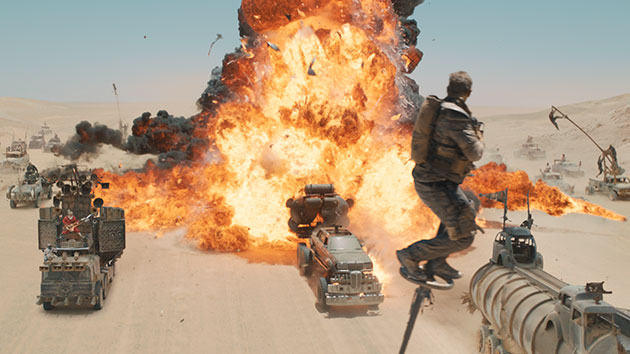
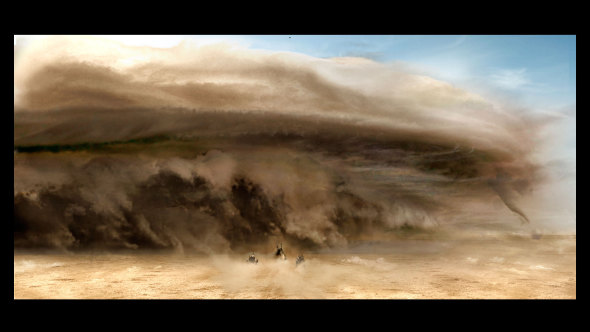
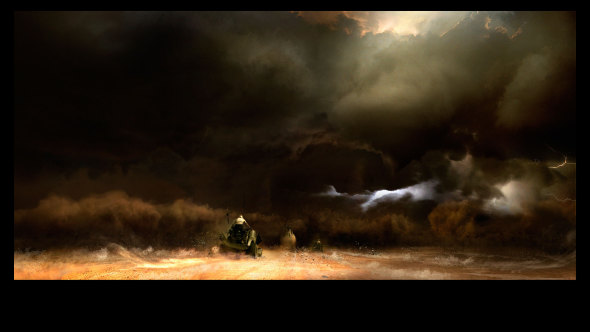
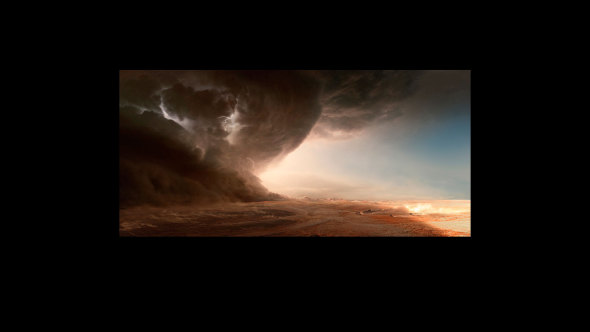
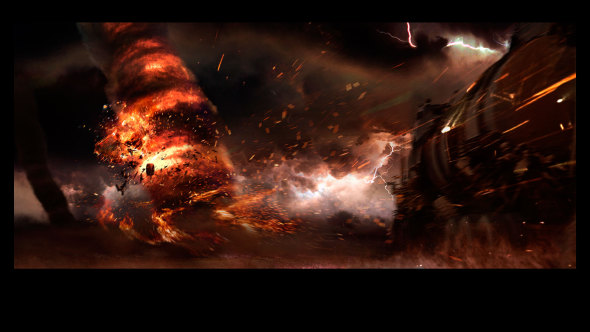
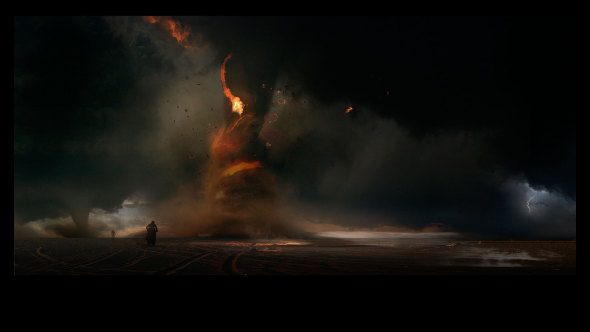
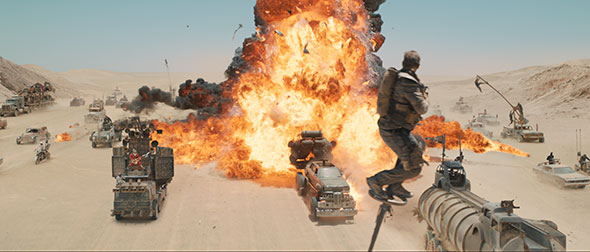










Leave a Reply